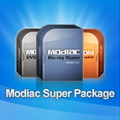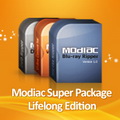Cada día ofrecemos un programa licenciado GRATIS que de otra manera tendrías que comprar!

Giveaway of the day — Modiac Super Package
Modiac Super Package estaba como Giveaway el día n 3 de marzo de 2011
Modiac Super Package incluye Modiac Blu-ray ripper, Modiac Video Converter y Modiac DVD ripper. Todo lo que necesita es hacer hacer clic en el panel un par de veces, y Modiac le ayudará a copiar discos Blu-ray / DVD / videos en cualquier formato popular que desee.
Además Modiac ofrece varias opciones avanzadas, lo que hace que sea más fácil para lograr personalizar su propio video. Así que si usted tiene Modiac Super Package, no necesitará ningún otro software de terceros.
The current text is the result of machine translation. You can help us improve it.
Requerimientos del Sistema:
Windows XP/ Vista/ 7
Publicado por:
all publishersPágina Oficial:
http://www.modiac.com/Tamaño del Archivo:
23 MB
Precio:
$49.95
Mejores Titulos

Buy lifetime updates and technical support for Modiac Super Package now! Only $29.95!
Comentarios en Modiac Super Package
Please add a comment explaining the reason behind your vote.
When you register the products [there are three] you must register all three individually with different codes.
The email address is the same for each: Giveawayoftheday@modiac.com
The License code is also the same except the last two letters of the License code.
The License Codes are listed in the Readme.txt file included with the download file.
#14: "I have tried to convert a purchased DVD to iPad format. The program begins the conversion but instantly reports succeeded and leaves about a 250 byte file. No conversion is accomplished."
I'd suggest trying it on a DVD you've copied to or created on your hard drive without DRM -- if it doesn't work you might try to pursue it with the devs. If it works OK, try the DVD that's giving you problems -- if it doesn't work from your hard drive, whatever you used to bypass DRM didn't work.
* * *
#25: "It is clear the Blue-ray ripper must be connected to the net to work. How about the other two products do they also need to be connected to the net to work?"
All 3 phone home when started, & that's with check for updates unchecked in options.
* * *
In case it helps with DVD/BD discs...
DVD Without DRM...
Audio/video/subs are stored in VIDEO_TS\*.VOB files [largest set = main title], with directions for players stored in .IFO files. IFO files divide titles into 1 or more cells -- a cell can be thought of as a bookmark pointing to a specific mpg2 I frame [note that after re-encoding I frames will be different]. Chapters only occur at cells, but a cell doesn't have to be a chapter; every title has a IFO file that includes a playlist of what cells to play, in what order [you can skip parts (e.g. commercials) or have different versions without having duplicate video on disc]; & if you're burning a dual layer DVD, the Layer Break has to happen at a cell [ideally the layer break is at the 50% mark of *all* data burned to that disc]. Software may list or include all cells, or just those that are also chapters -- you need to know what you've got, especially since many DVD authoring apps (& most DVD Recorders) insert all sorts of extra cells. If in doubt an app like Chapter Xtractor can help tell which cells are Chapters too. You can store & use chapters with Many non-DVD formats (including Windows Media). DVDs can be edited with IFOEdit [Old] &/or PgcEdit &/or VOBBlanker, to an extent -- it can be easier/faster to create new rather than editing what's already there. Sometimes you can add features not included in your DVD authoring software by editing afterward, e.g. adding sub &/or audio tracks & even scripting.
Getting content out of a DVD file layout isn't hard, but adding an extra step can make it easier -- DVD Shrink [or Nero Recode] can create a new DVD layout, leaving behind stuff you don't want, be it menus, audio tracks, extras, &/or trimming off something like the end credits, but make sure you're just copying & not further compressing video (unless you want/need that too). [Mpeg2 uses I frames (complete video frames) with partial frames in between -- Shrink/Recode delete data from those partial frames to make mpg2 video files smaller, & it's very hard (if possible) to see a difference when/if you retain 90% + of the original... if it's projected below 90%, seriously consider re-encoding instead.]. Many video apps will accept IFO &/or VOB files, Shrink can copy a DVD title to just one large VOB file [often easier/better than joining IMHO], & PGCDemux will extract individual video, audio, & subtitle files while saving cell times to a text file. Note however that while better DVD authoring apps accept .m2v video [mpg2 video only -- no audio], *Many* video apps will not -- in those cases mux .m2v with or without audio to get a .mpg file [note that .mpg includes more timing info than .m2v, so even when/if .m2v works, .mpg may work better/faster].
Also note that AC3 audio files can be broken yet still play fine, can have different bit rates, are independent of video on DVDs so they can be set to start late, may have excessive dynamic range [many (most?) players compensate], & that many versions of software players will not handle 5.1 channel AC3. Whether you're backing up a DVD you own, working with a disc from your DVD recorder, &/or want to convert to another format, it's often worthwhile to convert AC3 to stereo .wav, edit as/if necessary [e.g. applying dynamic compression to theater tracks or cleaning up those you've recorded], up the volume a bit, then check sync before final (re)encoding. Converting 5.1 AC3 or a DTS file to smaller stereo AC3 is also one effective way to reduce a DVD's size. All of that can apply as well to digital OTA [Over The Air] &/or QAM video you've saved [you save the original stream rather than encode/record, so almost any PC/laptop should be able to do it].
DVD subtitles are stored in separate streams as a graphics overlay & can sometimes be difficult to work with. If you need text files you can use OCR apps like suprip, but be prepared to do a bit of editing/correcting. North American retail DVDs &/or mpg2 Digital OTA/QAM usually include CC embedded in the video, it's often the same text used to create DVD subs, & it can be extracted. Few apps do everything with CC or subs, so it's often necessary to create a workflow based on the main video or DVD related tools you use -- fortunately there are a lot of subtitle related apps to fill in where you need.
* * *
Blu-Ray Without DRM...
Blu-Ray is harder & easier, both for the same reason -- there's just not a whole lot of software available... you're not going to create or recreate Java menus, so for example that's Not something you have to worry about. Instead of VOB files Blu-Ray content is stored in BDMV\STREAM\*.m2ts files, with titles sometimes spanning dozens. Just like with DVD VOB files many apps will open or play m2ts as is. Tools to extract the streams [e.g. BluRip] are available. While Blu-Ray can use mpg2, it can also be (& usually is) H264, or (more rarely) VC1, & most apps will not work with those last 2 unless they're encased in a container like avi, mkv, mov etc. -- .mkv is most common. Decoding this video to work with it can often be iffy, even if/when you're the one that encoded something like an HD QAM stream to AVC to begin with. IF you're new to whatever encoding/transcoding app., until you *know* what it'll work with watch carefully for artifacts in re-encoded video that look similar to what you see with digital cable when the signal drops out momentarily. Total video length can also vary depending on the source video, its container, & the app you're using, which *can* cause audio sync issues -- if the app doesn't take or handle multiple tracks &/or channels or work with your audio all that well, doing the audio separately can potentially become a nightmare when/if video fps is reduced in places. While all 3 types of video use full key frames, it's more complicated with H264 & VC1, plus the kay frames are often more widely spaced, so trimming, especially from the beginning end of the track can be iffy. And finally, watch out for fps [Frames Per Second] issues... there should be little or no practical difference between 23.976 & 24 fps video, but with some apps it matters a LOT, so be careful & run short test videos through your planned workflow before you commit your entire project to a long render that may turn out useless [keep an eye on encoding speed -- too long may mean the app's doing extra, quality-losing conversions -- watch for stuttering &/or ghosting in the output, particularly during pans/zooms, & don't forget to check audio sync].
If you're backing up a Blu-Ray disc you own you might be able to use the content as-is, or at most convert the huge DTS audio to much smaller AC3, & with Blu-Ray blanks now less than $1, that's a pretty reasonable alternative IMHO to risking a $20-30 disc with the kids. BD burners however, while available on sale for <$100, are still twice the price of drives that just read Blu-Ray... you can re-encode BD video small enough to fit on a regular DVD that normally plays fine. If you're using regular DVD blanks, stick with max DVD bit rates, & consider 1440x1080 & 720p frame sizes. AVC format looks better, but can take 4 times (or more) as long to encode as mpg2. multiAVCHD can create the disc layouts, but if you use something else [e.g. Nero, Roxio, Sony etc.] be sure to check compatibility with your newly encoded video -- it's more common than not for these apps to demand the video be encoded, again. Converting Blu-Ray HD to DVD shouldn't present any real challenges, though it'll take a bit longer because of the re-sizing, & make sure you use an app that understands 16:9 HD needs to become anamorphic 720 x 480, not letterboxed into a 4:3 frame. If you use an app like Sony Vegas you can turn 24p HD into NTSC DVD using pull-down -- flags embedded in the video file tell players to repeat certain frames to reach 29.976 fps, which is a significant time & space saver. If you're already transcoding DVDs for your hand-held or cell, you might prefer to convert Blu-Ray/HD to DVD, then proceed as normal -- many households have 1 Blu-Ray player, but several TVs & DVD players plus 1 or more hand-helds/cells, so that works out fine. There's nothing wrong with going directly from HD to very small screen sizes, but here the challenge is not every app will handle such a drastic resize all that well -- you might find it best to use an intermediate video file that you can use with VirtualDub &/or AviSynth, taking advantage of their more advanced re-size choices & capabilities.
As Terry #7 says, check out the FAQ. Notice FAQ #3 says the product must be used online. Could it be any more obvious that most of these products are spyware? They SHOULD have an option to NOT go to any "internet database" or phone home and just do their job quietly offline. Mind you the same is true of Win Media Player; it not only phones home but reports everything you play to both napster and Walmart. Check out all this activity yourself with a port viewer and decide what of this new breed of spyware you are willing to 'allow'.
Just sayin...
I think the FAQ page is good reading. Best done with a Chinese accent. Basic answers to some questions but amusing no less. Go here. http://www.modiac.com/faqs.htm.
Doesn't exactly fill you with confidence somehow but at least they are trying.:)
The website listed in #6 gives erroneous info...
DVD FAB for example DOES rip ANY DVD bluray or regular...
I have used it for years...updates have all been no cost and support is
very responsive...
It burns, shrinks whatever...
s


Un excelente software con muchas opciones y de facil manejo
Save | Cancel